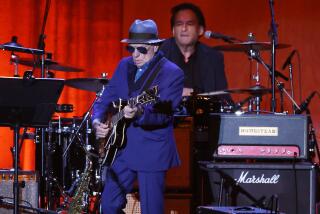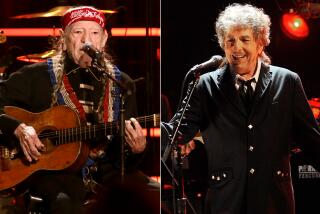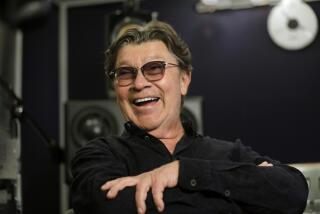POP MUSIC REVIEW : The Big Surprise at Orbison Tribute
“H ey! Mr. Tambourine man, play a song for me . ...” Roger McGuinn, David Crosby and Chris Hillman didn’t catch anyone off guard when they began singing that Bob Dylan song during a mini-Byrds reunion Saturday night at the Universal Amphitheatre.
“Mr. Tambourine Man” was the Byrds’ first hit, and it remains the tune most identified with the landmark Los Angeles folk-rock group from the ‘60s.
But there were gasps of surprise and delight during the four-hour Roy Orbison tribute concert when the threesome was joined half-way through the song by a surprise guest . . . Dylan.
It was, Dylan said after the concert, the first time he had appeared with the three Byrds since the band, then a quintet, was making rock history by forging its new sound 25 years ago.
Despite extensive touring in recent years, Dylan continues to bring a sense of drama with him every time he walks on stage, and he did so again Saturday as he first shared a microphone with Crosby, then with McGuinn.
Wearing dark glasses, a white jacket and black trousers, rock’s most acclaimed songwriter remained on stage while McGuinn moved into “He Was a Friend of Mine,” another Byrds favorite. McGuinn dedicated the song to Orbison, the classic rock singer and songwriter who died in 1988 at the height of a dramatic comeback that included his work with Dylan and others in the Traveling Wilburys supergroup.
The four musicians were then joined by about four dozen other members of the evening’s large cast to close the benefit concert with Orbison’s signature song, “Only the Lonely.” The organizers of the concert hope the show and an upcoming cable-TV special will raise about $3 million for homeless organizations.
Though the Dylan-Byrds appearance will likely be the most treasured moment of the cable special that is planned for this spring by Showtime, there were numerous other emotional highlights sprinkled in the program.
They included k.d. lang’s show-stopping rendition of Orbison’s “Crying,” Dean Stockwell’s re-creation of his eerie, unsettling lip-syncing rendition of “In Dreams” from the film “Blue Velvet” and the first performance by Bonnie Raitt since winning four Grammys on Wednesday night.
It was a fitting first outing for Raitt because she, much like Orbison, has rallied against career disappointment to achieve renewed commercial and critical acclaim.
While the 40-year-old singer didn’t fall as far from the spotlight as Orbison did during the ‘70s and early ‘80s, there were questions about her future after she was dropped in 1986 by her longtime record company, Warner Bros.
But Raitt bounced back last year with “Nick of Time,” which earned her a Grammy for album of the year. Rather than sing the album’s title track Saturday, Raitt dueted with John Lee Hooker on their Grammy-winning “I’m in the Mood,” then sang a tune identified with Orbison, the rowdy, energetic “Candy Man.”
Several of the evening’s performances captured various aspects of Orbison’s musical spirit, including the rockabilly zest of John Fogerty’s “Ooby Dooby,” the romantic paranoia of Benny Mardones’ “Running Scared” and the sweet dream portrait of Chris Isaak’s “Leah.”
But it was perhaps Raitt who best conveyed Orbison’s sense of dignity--the respect he had for music that was from the heart rather than music that was manufactured for the charts; a respect that made him feel part of a musical community that could use its power to help others rather than just celebrate his own accomplishments.
It was in that spirit that Raitt accepted her Grammys on behalf of all the blues artists who had inspired her and spoke backstage Saturday about the need for more blues and other roots-related music on mainstream radio.
On a purely musical level, there were problems with the Amphitheatre concert, many of them tied to a cast that included some singers and, especially, actors who are severely mismatched when trying to compete against the memory of one of rock’s greatest singers ever. No one, for instance, is ever going to ask Gary Busey to play the lead in “The Roy Orbison Story.”
Yet the generous parade of performers added to the sense of community that is becoming an increasingly prominent and rewarding part of the pop landscape. Plus, the fact that artists as varied as Emmylou Harris, John Hiatt, Booker T. Jones, Joe Ely, Cindy Bullens, Michael McDonald and members of the Talking Heads can find common ground in the music of a single writer also underscores the richness and range of Orbison’s grand musical legacy.
More to Read
The biggest entertainment stories
Get our big stories about Hollywood, film, television, music, arts, culture and more right in your inbox as soon as they publish.
You may occasionally receive promotional content from the Los Angeles Times.









